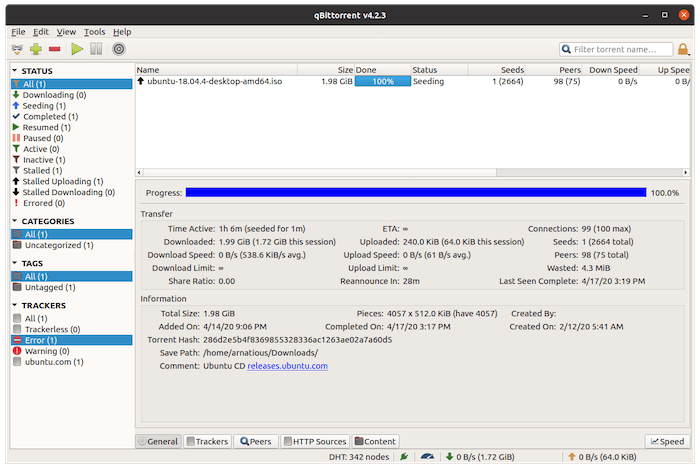How To Install qBitTorrent on AlmaLinux 9

In the vast landscape of file-sharing applications, qBittorrent stands out as a powerful, open-source BitTorrent client that has gained immense popularity among users worldwide. This feature-rich software offers a lightweight yet robust solution for downloading and sharing files through the BitTorrent protocol. With its user-friendly interface and advanced functionalities, qBittorrent has become a go-to choice for many Linux enthusiasts, including those running AlmaLinux 9.
qBittorrent boasts an impressive array of features that set it apart from other torrent clients. Its integrated search engine allows users to find torrents directly within the application, eliminating the need for external websites. The built-in torrent creation tool empowers users to share their own files effortlessly. Moreover, qBittorrent’s ability to handle magnet links, sequential downloading, and prioritization of files within a torrent makes it a versatile choice for various downloading needs.
BitTorrent clients play a crucial role in the world of file sharing, enabling users to distribute and access large files efficiently. The peer-to-peer nature of the BitTorrent protocol ensures faster downloads by leveraging the collective bandwidth of multiple users. qBittorrent excels in this arena, offering advantages over other popular clients like uTorrent and Deluge. Its open-source nature ensures transparency and continuous improvement, while its cross-platform compatibility makes it accessible to users across different operating systems.
Understanding AlmaLinux 9
Before diving into the installation process, it’s essential to understand the platform we’re working with: AlmaLinux 9. This enterprise-grade Linux distribution emerged as a stable, community-driven alternative to CentOS, following Red Hat’s announcement to shift CentOS to a rolling release model. AlmaLinux is a 1:1 binary compatible fork of Red Hat Enterprise Linux (RHEL), ensuring seamless compatibility with RHEL-based systems.
AlmaLinux 9, the latest major release, brings a host of improvements and new features to both server and desktop environments. It offers enhanced security measures, including integrity measurement architecture (IMA) and file system integrity tools. The distribution also provides better performance optimizations, making it an excellent choice for running resource-intensive applications like qBittorrent.
Prerequisites for Installation
Before proceeding with the installation of qBittorrent on AlmaLinux 9, it’s crucial to ensure that your system meets the necessary requirements and is properly prepared. Let’s go through the essential prerequisites:
System Requirements
While qBittorrent is known for its efficiency, it’s still important to have a system that can handle its operations smoothly. Here are the minimum hardware requirements:
- CPU: 1 GHz processor (dual-core recommended for optimal performance)
- RAM: 1 GB (2 GB or more recommended for handling multiple torrents)
- Storage: At least 100 MB for the application, plus additional space for downloads
- Network: A stable internet connection (broadband recommended for faster downloads)
Necessary Preparations
To ensure a smooth installation process, follow these preparatory steps:
- Update your system:
sudo dnf updateThis command will ensure that your AlmaLinux 9 system has the latest updates and security patches.
- Enable the EPEL (Extra Packages for Enterprise Linux) repository:
sudo dnf install epel-releaseThe EPEL repository provides additional packages not included in the standard AlmaLinux repositories, including qBittorrent.
By completing these preparations, you’ll have a solid foundation for installing qBittorrent on your AlmaLinux 9 system.
Installing qBittorrent on AlmaLinux 9 Desktop
Now that we’ve covered the basics and prepared our system, let’s dive into the step-by-step process of installing qBittorrent on AlmaLinux 9 Desktop. This method is ideal for users who prefer a graphical interface and want to run qBittorrent directly on their desktop environment.
Step-by-Step Installation Guide
- Open the terminal on your AlmaLinux 9 desktop. You can usually do this by pressing Ctrl+Alt+T or searching for “Terminal” in the applications menu.
- Install qBittorrent using the following command:
sudo dnf install qbittorrentThis command will download and install qBittorrent along with any necessary dependencies.
- When prompted, type ‘y’ and press Enter to confirm the installation.
- Once the installation is complete, you can verify it by launching qBittorrent from the applications menu. Look for the qBittorrent icon or search for it in the menu.
Configuring Firewall Settings
To ensure that qBittorrent can function properly and communicate with peers, you need to configure your firewall settings. AlmaLinux 9 uses firewalld by default, so we’ll use the firewall-cmd command to make the necessary changes.
- Open the necessary ports for qBittorrent:
sudo firewall-cmd --permanent --add-port=8080/tcpThis command opens port 8080, which is commonly used by qBittorrent for incoming connections.
- Reload the firewall to apply the changes:
sudo systemctl reload firewalld
Initial Setup and Configuration
After successfully installing qBittorrent and configuring the firewall, it’s time to set up the application for first use:
- Launch qBittorrent from the applications menu.
- On first launch, you’ll be greeted with a setup wizard. Follow the prompts to configure basic settings such as the default save location for downloads.
- Once the wizard is complete, you’ll see the main qBittorrent interface.
- Go to Tools > Options to access more detailed settings.
- In the Options window:
- Under the “Downloads” tab, you can set speed limits and configure connection settings.
- In the “Connection” tab, ensure that the correct port is set (8080 by default, as we configured in the firewall).
- Explore other tabs to customize qBittorrent according to your preferences.

With these steps completed, you now have a fully functional qBittorrent client running on your AlmaLinux 9 desktop, ready to handle your file-sharing needs efficiently.
Installing qBittorrent-nox on AlmaLinux 9 Server
For users running AlmaLinux 9 in a server environment or those who prefer a headless setup, qBittorrent-nox is the ideal solution. This version of qBittorrent runs without a graphical interface, allowing for remote management through a web-based UI. Let’s explore how to set this up on your AlmaLinux 9 server.
Introduction to qBittorrent-nox
qBittorrent-nox is the headless version of qBittorrent, designed specifically for server environments or systems without a graphical desktop. It offers all the powerful features of qBittorrent but runs as a background service, accessible via a web interface. This setup is perfect for users who want to manage their downloads remotely or run qBittorrent on a dedicated server.
Installation Process
Follow these steps to install qBittorrent-nox on your AlmaLinux 9 server:
- SSH into your AlmaLinux 9 server. If you’re using a local terminal, you can skip this step.
- Update your system to ensure you have the latest packages:
sudo dnf update - Install qBittorrent-nox using the following command:
sudo dnf install qbittorrent-nox - When prompted, type ‘y’ and press Enter to confirm the installation.
Setting Up the Web UI
After installing qBittorrent-nox, you need to set it up as a service and configure the Web UI for remote access:
- Create a system user for qBittorrent-nox:
sudo useradd -r -s /sbin/nologin qbittorrent - Create a systemd service file for qBittorrent-nox:
sudo nano /etc/systemd/system/qbittorrent-nox.serviceAdd the following content to the file:
[Unit] Description=qBittorrent-nox service After=network.target [Service] Type=forking User=qbittorrent ExecStart=/usr/bin/qbittorrent-nox -d Restart=on-failure [Install] WantedBy=multi-user.target - Save the file and exit the editor (in nano, press Ctrl+X, then Y, then Enter).
- Reload the systemd manager to recognize the new service:
sudo systemctl daemon-reload - Enable and start the qBittorrent-nox service:
sudo systemctl enable qbittorrent-nox sudo systemctl start qbittorrent-nox - Configure the firewall to allow access to the Web UI:
sudo firewall-cmd --permanent --add-port=8080/tcp sudo firewall-cmd --reload
Now that qBittorrent-nox is set up and running, you can access the Web UI by opening a web browser and navigating to http://your_server_ip:8080. The default username is “admin” and the password is “adminadmin”. It’s crucial to change these credentials immediately for security reasons.
Troubleshooting Common Issues
While installing and setting up qBittorrent on AlmaLinux 9 is generally straightforward, you might encounter some issues. Here are solutions to common problems:
Common Installation Errors
- EPEL Repository Unavailable: If you encounter errors related to the EPEL repository, try the following:
- Ensure your internet connection is stable.
- Update the dnf cache:
sudo dnf clean all && sudo dnf makecache - If issues persist, manually download and install the EPEL release package from the Fedora Project website.
- Dependency Conflicts: In rare cases, you might face dependency issues. Try resolving them by running:
sudo dnf update --best --allowerasingThis command will attempt to resolve conflicts by updating or replacing conflicting packages.
Web UI Access Problems
If you’re having trouble accessing the qBittorrent-nox Web UI, try these solutions:
- Check Firewall Settings: Ensure that port 8080 (or your configured port) is open:
sudo firewall-cmd --list-allIf the port is not listed, add it:
sudo firewall-cmd --permanent --add-port=8080/tcp sudo firewall-cmd --reload - Verify Service Status: Check if qBittorrent-nox is running:
sudo systemctl status qbittorrent-noxIf it’s not active, start it:
sudo systemctl start qbittorrent-nox - Check Logs for Errors: View the qBittorrent-nox logs for any error messages:
sudo journalctl -u qbittorrent-nox
Advanced Configuration Tips
Once you have qBittorrent up and running on your AlmaLinux 9 system, consider these advanced configuration tips to optimize performance and enhance security:
Optimizing Performance
- Adjust Connection Limits: In the Options > Connection tab, set the “Global maximum number of connections” to a value that your system can handle without slowing down. A good starting point is 500-1000 connections.
- Configure Bandwidth Limits: Set upload and download speed limits in the Options > Speed tab to prevent qBittorrent from consuming all your bandwidth.
- Use Disk Cache: In the Options > Advanced tab, enable disk cache to reduce disk I/O and improve performance, especially for systems with ample RAM.
- Enable Asynchronous I/O: In the same Advanced tab, enable asynchronous I/O for improved performance on multi-core systems.
Security Enhancements
- Change Default Credentials: For qBittorrent-nox, immediately change the default username and password in the Web UI settings.
- Use HTTPS for Web UI: Configure qBittorrent-nox to use HTTPS for secure remote access. You can use a reverse proxy like Nginx with Let’s Encrypt for this purpose.
- Implement IP Filtering: In the Options > Connection tab, you can add IP filters to block known malicious peers.
- Enable Anonymous Mode: In the Options > BitTorrent tab, enable “Anonymous Mode” to add an extra layer of privacy to your torrent activities.
Congratulations! You have successfully installed qBitTorrent. Thanks for using this tutorial for installing the qBitTorrent on AlmaLinux 9 system. For additional help or useful information, we recommend you check the qBitTorrent website.